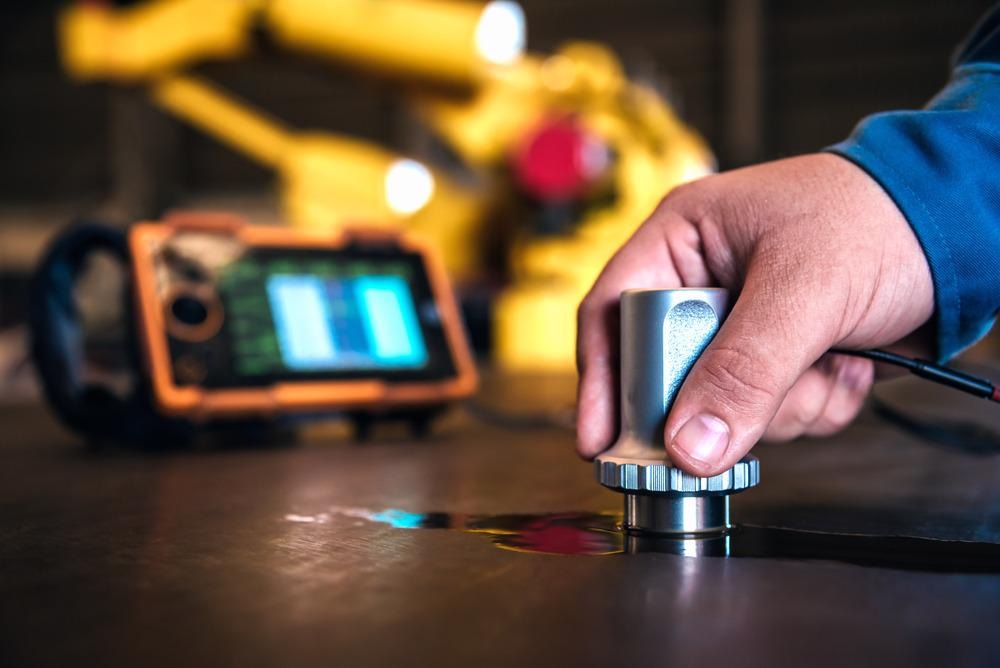The use of ultrasound in the industry for non-destructive testing (NDT) has multiplied in recent years, but it has mostly been limited to inspections at room temperature in radiation-free, chemically-safe environments.

Image Credit: N_Sakarin/Shutterstock.com
The majority of the sensing instruments are made up of a lead-zirconate-titanate (PZT) piezoelectric material with a critical temperature of around 100 ◦C and other plastic parts that cannot withstand temperatures beyond 200 ◦C.
Furthermore, the deterioration of adhesives and the failure of different transducer components would put classic ultrasonic transducers in severe environmental conditions at risk.
Ultrasonic Sensor for Harsh Environment
Non-destructive testing (NDT) is an ultrasonic method that is often used to locate defects in metallic components as well as to identify local impairments in structures. Ultrasonic testing successfully identifies cracks, impurities, and other quality and durability-degrading elements. Additionally, wear and corrosion indications on storage tanks, vessels, pipes, and pipelines, as well as machinery and components, can be promptly and reliably detected.
Solid bonding approaches such as welding would result in cracks or even complete sensor failure due to variable thermal expansion of the piezo-element, and wear surface. Researchers have investigated the viability of employing dry coupling at much lower restraining pressures rather than 200–500 MPA inter-layer pressure often used to achieve good dry coupling effectiveness.
Their sensor is spring supported to keep a consistent interfacial pressure as the sensor endures high thermal excursions; they illustrated that hard coupling at pressures above 20 MPA can result in a high transmission ratio and transmitter amplitude by using soft coupling foils at each sensor component interface.
Instruments Used for Ultrasonic Nondestructive Techniques
Ultrasonic detecting instruments employ sound waves to scan the interior structure of a component, producing extremely detailed images comparable to X-rays.
In industrial contexts, interferometry technology, initially designed for diagnostic imaging, is utilized to make cross-sectional images.
The aviation industry and metalworking companies employ large scanning equipment to check for hidden faults in raw materials and final items. Transmission analyzers and ultrasonic pulse/receivers are employed in several research applications.
Applications of Ultrasonic NDT
Ultrasonic detectors are widely utilized in a variety of applications, including viscoelastic analysis of industrial fluids, prevention of errors in composites or welds, and so on.
Ultrasonic detection has recently been shown to be effective in maintaining the strength properties of concrete materials throughout the hydrolysis process, which begins with high reactivity in the cement paste and concludes with the stiffening of the material.
This procedure may take many days, or even weeks, to complete, and its proper progression is critical for protecting people and structures.
A transmission materia, such as plexiglass, is placed in direct contact with the CBM in ultrasonic NDT. A transducer sends an ultrasonic pulse through the medium (frequencies ranging from 50 kHz to several MHz) and captures the echoes returned at the medium/cement contact. The frequency of the received echo may be used to determine how far the cement has progressed.
Ultrasonic Non-Destructive Techniques in SHM
Scientists at California University utilized piezoelectric wafer active sensors (PWAS) for non-destructive defect sensing.
PWAS are compact, low-cost, extrusive sensors that emit and receive ultrasonic pulse waves to detect cracking, erosion, spalling, and disbands in structures. These amazing sensors may be effortlessly fitted into a variety of structural elements.
The researchers employed this ultrasonic sensor to create an integrated SHM. Their integrated SHM uses a network of sensors, data extractors, and radio transmitters to assess and identify any structural deterioration that may develop during the infrastructure's lifespan.
Advantages of Ultrasonic NDT Sensors in Harsh Environment
Ultrasonic sensors broadcast and receive sound waves using an ultrasonic actuator. The signals are acquired by the sensing device and decoded after being rebounded from the item to be examined. Ultrasonic sensors are often employed in harsh industrial applications since they are unaffected by illumination, pollution, or smog and are independent of the strength and color of the target to be detected. With background reduction, they work extremely accurately and predictably.
Potential Limitations of Ultrasonic Testing
Ultrasonic defect sensing needs the employment of a skilled technician who can properly set up a test and assess the data using appropriate reference standards.
Certain intricate designs may also be hard to observe. Ultrasonic thickness gauges must be adjusted for the component being examined, and operations that need a wide variety of measuring methods or the detection of a wide range of materials may require many setups. Ultrasonic sensors are more expensive than conventional thickness gauges.
Continue reading: Non-Destructive Examination of Building Materials with Sensors.
References and Further Reading
Sinclair, A. N., and Malkin, A. (2020) Sensors for ultrasonic non-destructive testing (NDT) in harsh environments. Sensors 20 (2), 456. Available at: https://www.mdpi.com/1424-8220/20/2/456
R. Matera., V. Meacci., S. Rossi., D. Russo., S. Ricci., D. Lootcns. (2018) Smart Ultrasound Sensor for Non-Destructive Tests. IEEE. Available at: https://doi.org/10.1109/NGCAS.2018.8572207
Towsyfyan, H, et al. (2020) Successes and challenges in non-destructive testing of aircraft composite structures. Chinese Journal of Aeronautics 33.3 (2020): 771-791. Available at: https://doi.org/10.1016/j.cja.2019.09.017
Disclaimer: The views expressed here are those of the author expressed in their private capacity and do not necessarily represent the views of AZoM.com Limited T/A AZoNetwork the owner and operator of this website. This disclaimer forms part of the Terms and conditions of use of this website.